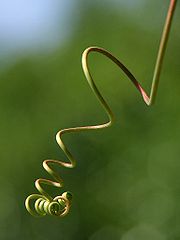Vines
A vine is any plant of genus Vitis (the grape plants) or, by extension, any similar climbing or trailing plant. The word, derived from Latin vīnea, referred to the grape-bearing variety. The modern extended sense is restricted to North American English, which uses grapevine to refer to the grape-bearing Vitis species. (British English tends to use climber to refer to the broader category, including, for example, ivy.)This article uses the term vine in its broader, North American sense.
Climbing plants
Certain plants always grow as vines, while a few grow as vines only part of the time. For instance, poison ivy and bittersweet can grow as low shrubs when support is not available, but will become vines when support is available.This has been a highly-successful growth form for plants such as kudzu and Japanese honeysucker, both of which are invasive exotics in parts of North America. There are some tropical vines that develop skototropism, and grow away from the light, a type of negative phototropism. Growth away from light allows the vine to reach a tree trunk, which it can then climb to brighter regions.
The vine growth form may also enable plants to colonize large areas quickly, even without climbing high. This is the case with periwinkle and ground ivy. It is also an adaptation to life in areas where small patches of fertile soil are adjacent to exposed areas with more sunlight but little or no soil. A vine can root in the soil but have most of its leaves in the brighter, exposed area, getting the best of both worlds.
A climbing habit has evolved independently in several plant families, using many different climbing methods. Some plants climb by twining their stems around a support (e.g., morning glories, Ipomoea species). Others climb by way of adventitious, clinging roots (e.g., ivy, Hedera species), with twining petioles (e.g., Clematis species), or using tendrils, which can be specialized shoots (Vitaceae), leaves (Bignoniaceae), or even inflorescences (Passiflora). Species of Parthenocissus (Vitaceae) produce twining tendrils that are modified stems, but which also produce adhesive pads at the end that attach themselves quite strongly to the support. The evolution of a climbing habit has been implicated as a key innovation associated with the evolutionary success and diversification of a number of taxonomic groups of plants.
Most vines are flowering plants. These may be divided into woody vines or lianas, such as wisteria, kiwifruit, and common ivy, and herbaceous (nonwoody) vines, such as morning glory.
One odd group of vining plants is the fern genus Lygodium, called climbing ferns. The stem does not climb, but rather the fronds (leaves) do. The fronds unroll from the tip, and theoretically never stop growing. In the meantime, they can form thickets as they unroll over other plants, rockfaces, and fences.





